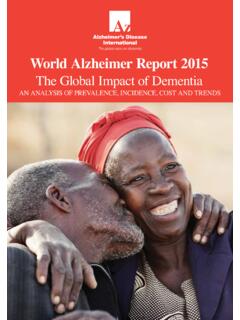Transcription of World Alzheimer Report 2018 - alzint.org
1 World Alzheimer Report 2018 The state of the art of dementia research:New frontiersPublished by Alzheimer s Disease International (ADI), 2018 Copyright Alzheimer s Disease International THE STATE OF THE ART OF DEMENTIA RESEARCH: NEW FRONTIERS3 Foreword ..41. Hope & frustration..62. What causes dementia? The basic science..83. The challenges of diagnosis..124. When will there be a cure? Drug discovery..165. Can I reduce my risk? ..236. Care needed..277. Every 3 seconds! The scale of the challenge..328. Dementia: It s my story..409. Glossary..42 About the authorChristina Patterson is a writer, broadcaster and consultant . Christina has written for many titles including Time magazine and The independent and currently writes for The Sunday Times and The Guardian in the United Kingdom. She is the author of The Art of Not Falling Apart, described by The Times as a beautifully written and uplifting memoir . The author was supported in the creation of this Report by Chris Lynch, Deputy CEO & Director of Policy, Communications & Publications; Annie Bliss, Communications & Policy Officer; Michael Lefevre, General Manager and Wendy Weidner, Research & Policy Project Lead at Alzheimer s Disease ContentsALZHEIMER S DISEASE INTERNATIONAL: World Alzheimer Report 20184 Welcome to the 2018 edition of the World Alzheimer Report : The state of the art of dementia research: New frontiers.
2 For many of you, used to reading the World Alzheimer Report each year, this will be a different Report in look, in feel and in tone. We have tried to answer a number of complex questions that have been in our minds at Alzheimer s Disease International (ADI). Overall the Report aims to clarify whether our call for increased research expenditure in dementia is still relevant and how much so. And indeed it is: compared with the number of people developing dementia one every 3 seconds the amounts devoted to research are tiny. For a start there isn t enough original research. The global ratio of publications on neurodegenerative disorders versus cancer is an astonishing 1:12. At the same time, not enough people are getting into research on dementia. While there are many reasons for this, it is not surprising, given that it has been 40 years since any significant breakthrough. Thirdly, despite a proliferating number of conferences and occasions for exchanging information we have to ask: are researchers and academics really sharing, using and disseminating data and using registries in the best possible way?
3 And is there enough involvement of people in Low and Middle Income Countries (LMICs) in the research process? Many countries have no diagnostic tools, no access to clinical trials and, indeed, few, if any, specialised doctors and researchers. Where those are present they may not have the means to travel and to communicate their ideas. Yet, with the biggest increases in dementia occurring in LMICs, does this make sense? Shouldn t the governments of those countries try to contribute to research for the benefit of their populations rather than relying on other countries, such as the USA and the UK, to lead the way?1 ForewordAre researchers and academics really sharing, using and disseminating data and using registries in the best possible way? THE STATE OF THE ART OF DEMENTIA RESEARCH: NEW FRONTIERS5 Some of the best and most illustrious minds in Alzheimer s and dementia research have been interviewed by renowned journalist Christina Patterson, who herself has had an important and life-changing family experience of dementia.
4 We hope the resulting Report will be an interesting read, both for those in the sector and for those who wonder what is happening in research and why a solution is not being found more quickly. That is not to say that the solution has to be scientific only; dementia is complex and the solution needs to be political and socioeconomic as , research is not just done in labs under microscopes. In the absence of a medical solution, we need more research and innovation around care, especially in domestic settings, as this field will grow both out of necessity and out of a preferred choice of where to live post-diagnosis. We need much more thinking, more research, more innovation and more dynamic entrepreneurship to find solutions. In short, we hope this will be an interesting and thought-provoking read whether you are in the industry or not, and I thank all participants for taking the time to contribute their great wealth of knowledge to this Report .
5 Our hope, as with everything we do, is that it will increase awareness of Alzheimer s disease and dementia and spark a debate which will lead to more governments dedicating funds and focus to help people with dementia and their families live better lives. ADI proposes that, nationally, 1% of the societal cost of dementia should be devoted to funding research in: basic science, care improvements, prevention and risk reduction, drug development and public health. Without significant investments in these areas of dementia research we will be unable to venture into new Barbarino CEO Alzheimer s Disease International1% of the societal cost of dementia should be devoted to funding research Alzheimer S DISEASE INTERNATIONAL: World Alzheimer Report 20186 Jennifer Bute was shocked when her patients started kissing her. Well, you don t, she told me with a slightly embarrassed smile, really hug and kiss the doctor, do you?
6 A couple of weeks later, she realized that the patient who had hugged her was a friend. Soon after, I wouldn t recognise people I had known for 20 years, then I started getting lost along familiar routes. That was kind of how it all started. Jennifer Bute is now 72. She looks younger. Her face is unlined. Her piercing blue eyes still give her the forensic air of a doctor assessing a patient. But she had to give up her work as a GP (a general doctor) when she was 58. At first, it was passwords. She couldn t remember passwords, or names. One day, she couldn t find the surgery. Another day, she announced to her guests that dinner was ready and her husband had to tell her that she had already cooked it, and they had eaten it three hours before. I diagnosed myself, she told me. The first neurologist wouldn t even do any tests. He said there s nothing the matter with you . But Bute knew there was, and she was right.
7 She now lives in a privately run care village in South West England. It was still called senile dementia when I stopped working, she said. Disgraceful! When I was working, very little was actually done proactively about dementia. We didn t actively search for it. I m ashamed of how I was as a GP. I didn t realise what could be done. Jennifer Bute is one of the 50 million people in the World with dementia, a global community around the size of South Korea or Spain. About two thirds, like Bute, have Alzheimer s. Others have vascular dementia, mixed dementia, Lewy body dementia 1 Hope & frustrationJennifer Bute is one of the 50 million people in the World with dementia, a global community around the size of South Korea or Spain. THE STATE OF THE ART OF DEMENTIA RESEARCH: NEW FRONTIERS7or frontotemporal degeneration (FTD). All of them have damage to the brain cells that can t be reversed. That community is likely to rise to about 152 million people by 2050, to one that s more the size of Russia or Bangladesh.
8 The current cost of the disease is about a trillion US dollars a year, and that s forecast to double by 2030. This figure includes an estimated cost for informal carers, the people who suddenly find themselves acting as 24-hour live in nurses to parents, husbands or wives. The annual global number of informal care is estimated at about 82 billion hours and 71% of these hours are supplied by s disease has taken over from cancer to become America s most feared disease. It kills more people in the US than breast cancer and prostate cancer combined. It s now the number one killer in England and Wales. There s a new case in the World every three seconds. Blink twice, and that s another one. It might be your mum. It might, one day, be you. Oh, and there s no 1998, 100 drugs have been tested and only four have been authorized for use. And these are not magic pills. They can help manage some of the symptoms of dementia, for some people, but only for some people, and most people in the World don t get near them.
9 But anyone who knows anything about the disease knows that there is not going to be a magic pill. Cure will not, said Doug Brown, former Chief Policy and Research Officer of the Alzheimer s Society, be a silver bullet. A cure for us is either something that can prevent someone from developing dementia in the first place, or can stop dementia in its tracks before it has caused too much damage. It s likely, he added, to be a multiple set of treatments and drugs. We were sitting in a glass-walled meeting room in the Alzheimer s Society s London office. It seemed to be buzzing. The atmosphere was surprisingly upbeat. Brown joined the organisation six years ago from a research background in malaria, stem cells, HIV and MS. Did he, I asked, notice any differences when he moved into the World of dementia research? Brown nodded and smiled. What struck me, he said, even though there weren t any disease-modifying treatments, was the breadth of the research that was happening, and the way that research was happening in such a collaborative fashion, and not just in the UK, but globally.
10 Over the six months I ve spent looking at the World of Alzheimer s and dementia research, and talking to some of its leading lights, I have learnt that he is right. There is a huge amount of research going on globally, in so many different fields. And Jennifer Bute s right, too. There is more that can be done for people with dementia than most people realise. In a field that can look very grim, there are plenty of seeds of S DISEASE INTERNATIONAL: World Alzheimer Report 20188So, what causes it? What happens in the brain that means that one day you can be the super-efficient executive partner of a large medical practice and the next day you can offer your guests a dinner they have already eaten? That, of course, is the trillion-dollar question, and it s one that doesn t yet have a clear scientists seem to agree that there are two proteins in the brain that are heavily involved. One is beta-amyloid, usually just called amyloid, which reaches abnormal levels in the brain of someone with Alzheimer s and forms plaques that collect between neurons and disrupt cell function.



